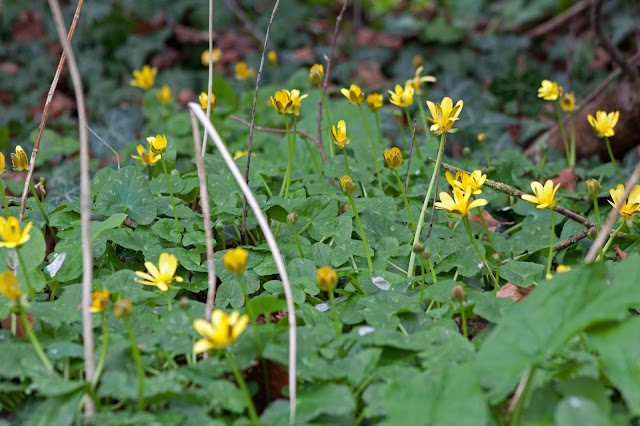A Very Different Mother's Day
In lieu of visiting my mum for Mother's Day for the second year running due to the Coronavirus lockdown, we ventured out for a local walk around Eynsham Wood and the surrounding fields. After a week of very unsettled, gusty weather, it was brilliant to get out for some much-needed fresh air, albeit having just missed out on some early morning sunshine. With temperatures still struggling just below double figures, and with steely grey skies and a lingering breeze, it still felt as though spring wasn't quite here yet.
There were however a few signs that the transition to warmer times is not so far away, with the lesser celandines Ficaria verna in full bloom, and hawthorn Crataegus monogyna leaves just beginning to burst.
 | |
| Lesser celandines in full bloom | |
 |
| Hawthorn leaves bursting |
The bird life was initially fairly quiet (possibly a product of our rather leisurely late morning start!), and the central bridleway hedgerows didn't produce much of note until about halfway along where a pair of redwing Turdus iliacus were inconspicuously perched at the top of an ash tree. As we approached westwards towards Eynsham Wood along the northern boundary bridleway, a sparrowhawk Accipiter nisus was glimpsed through the hedgerow flying over Field 1 and caused a few muted alarm calls from small birds; surprisingly the first time I have come across the species in 10 visits to this patch in 2021.
Having not managed to visit since late February, I was hoping to hear my first singing chiffchaff Phylloscopus collybita of the year from Eynsham Wood, and perhaps a first butterfly sighting too, but neither made an appearance (perhaps a little ambitious for the latter given the cool weather conditions). There were however a few bullfinches Pyrrhula pyrrhula calling, and a smart male chaffinch Fringilla coelebs sitting proud atop some dense scrub. Poor lighting and an some very out-of-pratice photography produced this slightly dull image.
 |
| Male chaffinch in scrub at Eynsham Wood |
As we headed towards the eastern fields, it quickly became apparent that both Field 4 and 5 had been ploughed in the past week or so. The change was particularly stark in Field 4, which had possibly been fallow for as much as two or three years prior according to aerial images, and had established some nice rough grassland, providing some good cover for small mammals and ground nesting birds, as well as winter food resources for meadow pipit Anthus pratensis and skylark Alauda arvensis amongst others. It served as a reminder to not grow too attached to any farmland habitats, as they can very quickly go back into production.
 |
| Field 4, newly ploughed |
A few starling Sturnus vulgaris, jackdaw Corvus monedula, rook C. frugilegus and black-headed gull Chroicocephalus ridibundus were eagerly searching through the newly churned up soil for invertebrates, and a couple of skylark (hardy as ever!) were still insistant on singing away high above the ploughed fields. Hopefully if the land is cultivated as a winter cereal crop in the coming weeks, there will still be an opportunity for a couple of pairs to make a nesting attempt this year.
 |
| Skylark singing above newly ploughed field |
Further on, a group of around 10-15 yellowhammer Emberiza citrinella were still searching around at the edges of Field 5 (previously winter stubble) for any remaining seeds, their bright yellow plumages extremely striking against the backdrop of brown ploughed earth. These yellowhammer were the last of the 22 bird species seen on the morning, and a nice way to cap off the walk.
Some very fresh badger Meles meles latrines (and some recent digging activity at the known sett on the western boundary of Field 5) were the only other noteworthy observations from the walk, but capped off a pleasant morning, and another day closer to the spring.
Comments
Post a Comment